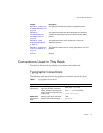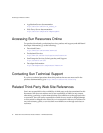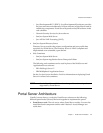Types of Portals
22 Portal Server 6 2005Q1 • Deployment Planning Guide
Portals serve as a unified access point to web applications. Portals also provide
valuable functions like security, search, collaboration, and workflow. A portal
delivers integrated content and applications, plus a unified, collaborative
workplace. Indeed, portals are the next-generation desktop, delivering e-business
applications over the web to all kinds of client devices. A complete portal solution
should provide users with access to everything users need to get their tasks
done—any time, anywhere, in a secure manner.
Types of Portals
With many new portal products being announced, the marketplace has become
very confusing. Indeed, any product or application that provides a web interface to
business content could be classified as a portal. For this reason portals have many
different uses and can be classified as one of the following:
• Collaborative Portals
• Business Intelligence Portals
Collaborative Portals
Collaborative portals help business users organize, find, and share unstructured
office content—for example, e-mail, discussion group material, office documents,
forms, memos, meeting minutes, web documents, and some support for live feeds.
Collaborative portals differ from Internet and intranet portals not only in
supporting a wider range of information, but also by providing a set of content
management and collaborative services.
Content management services include the following:
• Text mining (the discovery of new, previously unknown information)
• Clustering of related unstructured information
• Information categorization
• Summarization to generate abstracts for documents,
• Publishing and subscribing
• Finding people
• Tracking expertise
Collaborative portals are mainly used internally as a corporate facility.


















